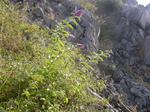| Home | About BFIS | Species List | Risk Analysis | Harmonia⁺ | Resources | Outputs | Mailing List | Registry |
| Contact us | Login | | ||||||
 |

©
Gilles San Martin

©
Etienne Branquart

©
Etienne Branquart

©
Sarah Brunel, EPPO
 Naturalization in Belgium Naturalization in Belgium
 Invasiveness Invasiveness
More on invasiveness: This deciduous shrub mostly thrives in various ruderal areas and disturbed grounds (e.g. railway embankments, fallow lands and sand quarries), but also in warm semi-natural habitats with well-drained soils like gravel shores, dunes or rock outcrops. The small and winged seeds can be carried great distances by the wind, water, and occasionally by cars. Climate change is likely to trigger higher invasiveness in Europe during the next decades.
 Distribution in Belgium Distribution in Belgium
Established populations

Endangered areas

 Impacts on Species Impacts on Species
 Impacts on Ecosystems Impacts on Ecosystems
More on impacts: Due to its strong dispersion potential, its high resource utilisation efficiency compared to native species and its ability to quickly form dense monospecific populations, the butterfly bush accelerates and dominate early successions and displaces native pioneer species living in open and sunny habitats. It also impedes the growth and reproduction of other species of trees and shrubs and is able to outcompete Betula pendula on nitrogen-poor soils as well as under conditions of water stress. It may alter soil N:P stoichiometry. Dense populations are however rarely observed in semi-natural habitats in Western Europe.
References:
AEF (2006)
Cartes provisoires de la distribution de néophytes en Wallonie.
Unpublished document.
Bellingham, P.J., Peltzer, D.A. & Walker, L.R. (2005)
Journal of Vegetation Science 16(1): 135–142.
Bellingham, P.J., Pelzer, D.A. & Walker, L.R. (2005)
Contrasting impacts of a native and an invasive exotic shrub on flood-plain succession.
Journal of Vegetation Science 16: 135-142.
Binggeli, P. (1998)
An overview of invasive woody plants in the tropics.
University of Wales, School of agricultural and forest sciences publication no 13.
CPS-SKEW (2006)
Buddleja davidii.
From online fact sheets of the Swiss Commission for Wild Plants Conservation.
Day, J., Nigel, S. & Robertson, P. (2003)
Forum on the application of conservation techniques, English Nature & RSPB.
Ebeling, S. (2008)
Does local adaptation facilitate the success of
plant invasions? – A case study on Buddleja davidii.
 PhD Thesis Martin-Luther-Universität Halle-Wittenberg.
Ebeling, S.K., Hensen, I. & Auge, H. (2007)
The invasive shrub Buddleja davidii performs better in its introduced range.
Diversity and Distributions 14(2): 225-233.
Ebeling,S.K., Welk, E., Auge, H. & Bruelheide, H. (2008)
Ecography 31(6): 709–719.
Feng, Y.L., Auge, A. & Ebeling, S.K. (2007)
Invasive Buddleja davidii allocates more nitrogen to its photosynthetic machinery than five native woody species.
Oecologia 153: 501-510.
Humphries, R.N. & Guarino, L. (1987)
Soil nitrogen and the growth of birch and buddleja in abandoned chalk quarries.
Reclam. Reveg. Res. 6: 55-61.
Humphries, R.N., Jordan, M.A. & Guarino, L. (1982)
The effect of water stress on the mortality of Betula pendula and Buddleja davidii seedlings.
Plant & Soil 64: 273-276.
Kriticos, D.J.,Watt, M.S., Potter, K.J.B., Manning, L..,Alexander, N.S. & Tallent-Halsell, N. (2010)
Managing invasive weeds under climate change: considering the current and potential future distribution of Buddleja davidii
 Weed Research, DOI: 10.1111/j.1365-3180.2010.00827.x
Lambinon, J., Delvosalle, L. & Duvigneaud, J. (2004)
Nouvelle fore de la Belgique, du Grand-Duché de Luxembourg, du Nord de la France et des régions voisines.
Editions du Patrimoine du Jardin botanique national de Belgique, Meise.
Muller, S. (2004)
Plantes invasives en France : état des connaissances et propositions d'actions.
Publication scientifique du Museum d'Histoire naturelle, Patrimoines naturels n°62.
Tallent-Hasell, N.G. & Watt, M.S. (2009)
The Invasive Buddleja davidii (Butterfly Bush).
Bot. Rev. DOI 10.1007/s12229-009-9033-0
Van Landuyt, W., Hoste, I., Vanhecke, L., Van den Bremt, P. Vercruysse, W. & De Beer, D. (2006)
Atlas van de Flora van Vlaanderen en het Brussels gewest.
Nationale Plantentuin en het Instituut voor Natuur- en Bosonderzoek i.s.m. Flo.Wer vzw.
Verloove, F. (2006)
Scripta Botanica Belgica 39, 89 pp.
Wittenberg, R. (2005)
CABI Bioscience Switzerland Centre report to the Swiss Agency for Environment, Forests and Landscape. The environment in practice no. 0629: 155p.
|
 |
 |





